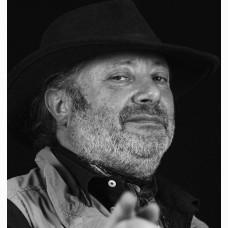Charlemagne Palestine

Born in 1947 in Brooklyn, New York, USA.
Lives and works in Brussels, Belgium.
Since the 1960s, he has worked as a visual artist and performer all over the world, in particular in the following venues: Palais des Beaux-Arts, Brussels - 39th Venice Biennale - 10th Paris Biennale - Whitney Biennial -Moderna Museet, Stockholm - Stedelijk Museum, Amsterdam - Documenta 8, Kassel - MOMA, New York - Walker Art Center, Minneapolis - Art Institute of Chicago - Centre Beaubourg, Paris - Centre d'Art Contem- porain, Geneva - Musée d'Art Contemporain, Montréal...
A multimedia artist and nomadic traveller, he has used many media and worked in multiple forms: painting, sculpture, music, video, performance.
The traditional music he sang as a child in synagogues was his first experience with ritual music; later he discovered the sound produced by church bells from which he developed a unique and personal style of "minimalist" music based on the duration, repetition and harmonic function of sound.
After studying at various American universities, he began a career in New York as a singer, painter, pianist, sculptor and performer while composing music and performing in the alternative venues that were springing up throughout America and Europe in the early 1960s.
From 1967 onwards, using electronic equipment, he worked with sound, which he projected and sculpted in space, then evolved by integrating instruments and voices.
From 1970 onwards, he began to experiment with a new form of body art performance, bringing together body and movement in time and space, generally known as body music. It was at this time that he and the American choreographer and dancer Simone Forti inaugurated a new form of performance including "Illuminations", which they produced in America and Europe. With this work, he discovered the Bösendorfer piano, which inspired him to create a series of minimalist musical forms that he called "Strumming music": improvisations for piano with repetitive sonorities that produced trance-like sensations in the spectator. He also used video in the 1970s to capture the energetic intensity and physical violence that he expended in his concerts. But from 1980 onwards, disillusioned with the art-video scene, he stopped making tapes and reflected on the sad uniformity of television programmes in terms of both content and editing, and in 1987 founded a non-profit organisation, Ethnology Cinema Project, dedicated to preserving and disseminating videos dealing with traditional cultures from around the world since the beginning of the century.
A stuffed animal mascot always accompanies him, sitting on the piano. Over the years, the mascot has continued to proliferate and dozens of cuddly toys have been piled up at the foot of the piano; these little bears and other fetishes linked to childhood became the raw material for his plastic creations, most often in the form of installations. Emblematic figures buried in the collective unconscious, Charlemagne Palestine raises them in his works to the rank of sacred divinities, in the form of altars or totems such as "God Bear", this 5-metre-high bear with two bodies and three heads, inaugurated at Documenta 8 in Kassel (1987) and which has since embarked on a long journey through museums and galleries throughout the world.
In the manner of a shaman, he starts with objects linked to personal experiences to create a mystical work which, through its energetic charge, induces irrational reactions in the spectator close to the magical state of childhood.




